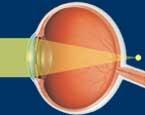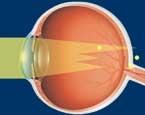Vision Disorders
Refractive errors cause decreased vision, visual discomfort ("eye strain"), and/or amblyopia. The most common form, near-sightedness (poor distance vision) is usually seen in school-age children and is treated effectively, in most cases, with glasses. Farsightedness can cause problems with focusing at near and may be treated with glasses. Astigmatism (imperfect curvature of the front surfaces of the eye) also requires corrective lenses if it produces blurred vision or discomfort. Uncorrected refractive errors can cause amblyopia particularly if they are severe or are different between the two eyes.
Below are a few conditions discussed briefly.
Myopia
In cases of mild or moderate myopia (short-sightedness) there is the ability to see close objects more clearly than distant objects, which, without glasses, would appear blurred. With more severe myopia, vision is more likely to be slightly impaired even with correct glasses. Strong lenses are needed to make the image even smaller and, in some cases, vision may be better with contact lenses.
-

Normal
-

Myopia
Farsightedness, or hyperopia, as it is medically termed, is a vision condition in which distant objects are usually seen clearly, but close ones do not come into proper focus. In mild cases of farsightedness, your eyes may have been able to compensate without corrective lenses. Many people are not diagnosed with hyperopia without a complete eye exam.
Farsightedness occurs if your eyeball is too short or the cornea has too little curvature, so light entering your eye is not focused correctly. The cornea and the lens work together to focus images from the visual world on the back of the eye (the retina). If an image is out of focus, it is typically because the overall shape of the eye is incorrect, or the cornea does not have the proper curvature.

Normal

Hyperopia
Astigmatism
Astigmatism occurs when the front surface of your eye (cornea) is slightly irregular in shape, resulting in vision being blurred at all distances.
In Astigmatism, the front of your eye is more oval than round, light does not focus properly on the back of your eye (retina).
The causes of this irregular shape are unclear. In some cases, it may be hereditary, or it may result from such factors as pressure of the eyelids on the cornea, incorrect posture or an increased use of the eyes for close work.

Normal
-

Astigmatism
Corneal dystrophies
The front of the eye is usually clear, but clouding may occur as an isolated problem or as part of a more generalized disorder. This results in reduced vision, amblyopia and photophobia (discomfort and dazzle in bright light). Occasionally fragility of the cornea surface and recurrent sore eyes occur due to spontaneous erosions.
Presbyopia
As we age, body tissues normally lose their elasticity. As the lenses in our eyes lose some of their elasticity, they lose some of their ability to change focus for different distances. The loss is gradual. Long before we become aware that seeing close up is becoming more difficult, the lenses in our eyes have begun losing their ability to flatten and thicken. Only when the loss of elasticity impairs our vision to a noticeable degree do we recognize the change.
With presbyopia the crystalline lens of your eye loses its flexibility, which makes it difficult for you to focus on close objects. Presbyopia may seem to occur suddenly, but the actual loss of flexibility takes place over a number of years.
Retinal dystrophy
The retina 'takes the picture' and processes an image to send as a signal to the brain. Some children are born with a malformed (dysplastic) retina but as it cannot be replaced (transplanted) this cannot be treated.
Retinal detachment
If the retina of the eye becomes displaced it is like taking the film out a camera and not being able to take a picture. Some Eye Conditions have a high risk of retinal detachment but in some cases the retina can be reattached by surgery. The chances of success are higher the sooner after detachment this is performed.
You will need the Adobe Reader to view and print these documents.
![]()







